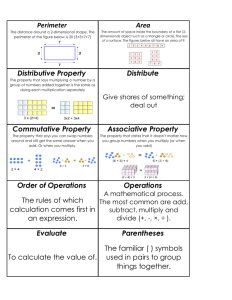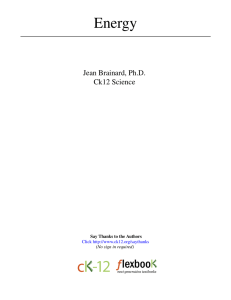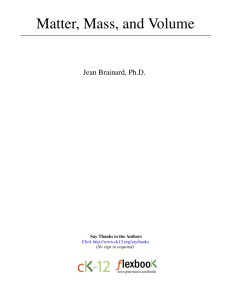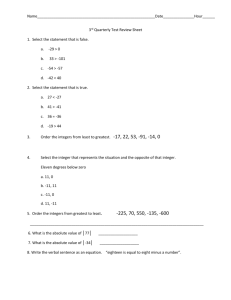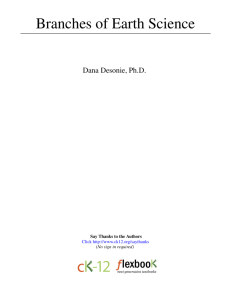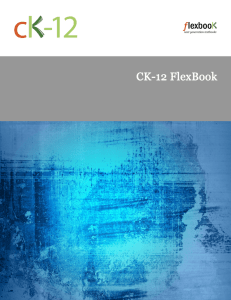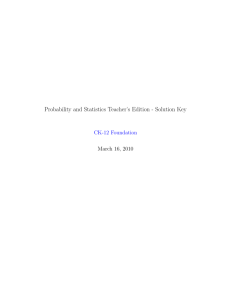Simplify Products or Quotients of Single Variable Expressions
advertisement
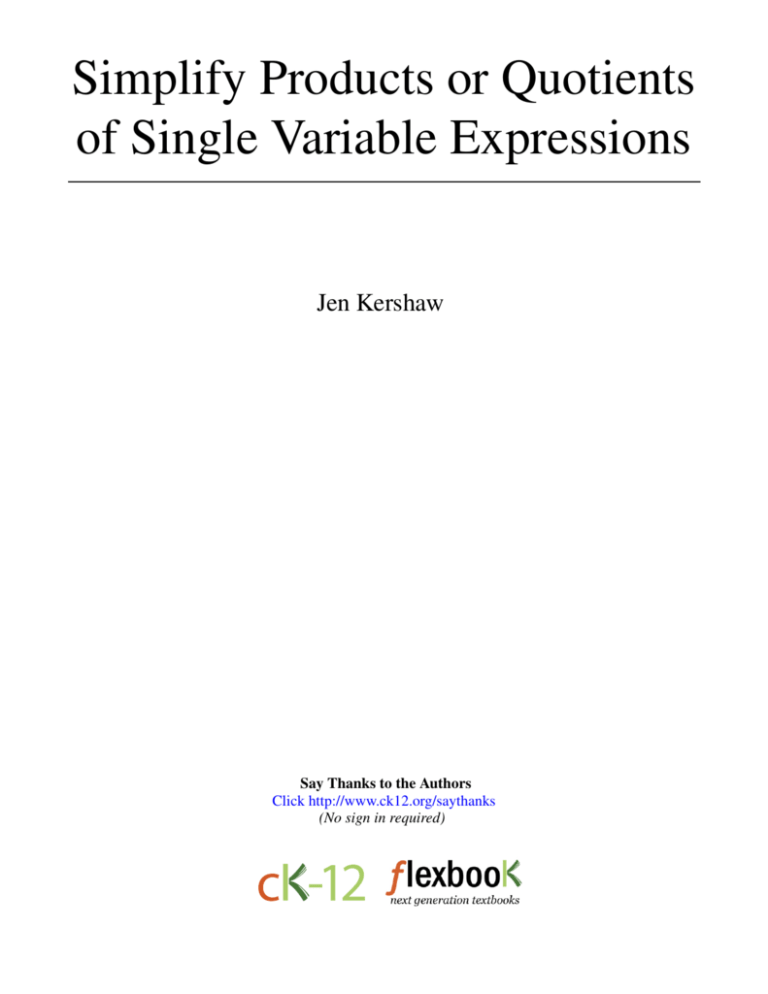
Simplify Products or Quotients of Single Variable Expressions Jen Kershaw Say Thanks to the Authors Click http://www.ck12.org/saythanks (No sign in required) To access a customizable version of this book, as well as other interactive content, visit www.ck12.org CK-12 Foundation is a non-profit organization with a mission to reduce the cost of textbook materials for the K-12 market both in the U.S. and worldwide. Using an open-content, web-based collaborative model termed the FlexBook®, CK-12 intends to pioneer the generation and distribution of high-quality educational content that will serve both as core text as well as provide an adaptive environment for learning, powered through the FlexBook Platform®. Copyright © 2013 CK-12 Foundation, www.ck12.org The names “CK-12” and “CK12” and associated logos and the terms “FlexBook®” and “FlexBook Platform®” (collectively “CK-12 Marks”) are trademarks and service marks of CK-12 Foundation and are protected by federal, state, and international laws. Any form of reproduction of this book in any format or medium, in whole or in sections must include the referral attribution link http://www.ck12.org/saythanks (placed in a visible location) in addition to the following terms. Except as otherwise noted, all CK-12 Content (including CK-12 Curriculum Material) is made available to Users in accordance with the Creative Commons Attribution/NonCommercial/Share Alike 3.0 Unported (CC BY-NC-SA) License (http://creativecommons.org/licenses/by-nc-sa/3.0/), as amended and updated by Creative Commons from time to time (the “CC License”), which is incorporated herein by this reference. Complete terms can be found at http://www.ck12.org/terms. Printed: August 25, 2013 AUTHOR Jen Kershaw www.ck12.org C ONCEPT Concept 1. Simplify Products or Quotients of Single Variable Expressions 1 Simplify Products or Quotients of Single Variable Expressions Here you’ll learn to simplify products or quotients of single variable expressions. Have you ever had a stamp collection? Marc has twice as many stamps in his collection as his Grandfather has in his. Write an expression to represent m, the number of stamps in his Grandfather’s collection. To solve this problem, you will need to know how to write a single variable expression. Pay attention to this Concept, and you will know how to do this by the end of the Concept. Guidance Previously we learned that when you add and subtract terms in an expression, you can only combine like terms. However, you can multiply or divide terms whether they are like terms or not. For example, 6a and 3a are like terms because both terms include the variable a. We can multiply them to simplify an expression like this. 6a × 3a = 18 × a × a = 18a2 . However, even though 6a and 3 are not like terms, we can still multiply them, like this. 6a × 3 = 18a. The Commutative and Associative Properties of Multiplication may help you understand how to multiply expressions with variables. Remember, the Commutative property states that factors can be multiplied in any order. The Associative property states that the grouping of factors does not matter. Let’s apply this information. 6a(3a) We can take these two terms and multiply them together. First, we multiply the number parts. 6 × 3 = 18 Next, we multiply the variables. 1 www.ck12.org a · a = a2 Our answer is 18a2 . Here is another one. 5x(8y) Even though these two terms are different, we can still multiply them together. First, we multiply the number parts. 5 × 8 = 40 Next, we multiply the variables. x · y = xy Our answer is 40xy. Find the product 4z × 21 . 4z and 1 2 are not like terms, however, you can multiply terms even if they are not like terms. Use the commutative and associative properties to rearrange the factors to make it easier to see how they can be multiplied. According to the commutative property, the order of the factors does not matter. So, 4z × 21 = 21 × 4z. According to the associative property, the grouping of the factors does not matter. Group the factors so that the numbers are multiplied first. So, 21 × 4z = 12 × 4 × z = 21 × 4 × z. Now, multiply. 1 4 1 4 2 × 4 × z = 2 × 1 × z = 2 × z = 2 × z = 2z. The product is 2z. Remember that the word PRODUCT means multiplication and the word QUOTIENT means division. Here is one that uses division. Find the quotient 42c ÷ 7. It may help you to rewrite the problem like this 2 42c 7 . Then separate out the numbers and variables like this. www.ck12.org 42c 7 = 42·c 7 = 42 7 Concept 1. Simplify Products or Quotients of Single Variable Expressions ·c Now, divide 42 by 7 to find the quotient. 42 7 · c = 6 · c = 6c The quotient is 6c. Now it’s your turn. Find each product or quotient. Example A 6a(9a) Solution: 54a2 Example B 15b 5b Solution: 3 Example C 20c 4 Solution: 5c Here is the original problem once again. Marc has twice as many stamps in his collection as his Grandfather has in his. Write an expression to represent m, the number of stamps in his Grandfather’s collection. To write this, we simply use the variable and the fact that Marc has twice as many stamps. 2m This term represents Marc’s stamps. Vocabulary Expression a number sentence without an equal sign that combines numbers, variables and operations. Simplify to make smaller by combining like terms. Product the answer in a multiplication problem. Quotient the answer in a division problem. Commutative Property of Multiplication states that the product is not affected by the order in which you multiply factors. 3 www.ck12.org Associative Property of Multiplication states that the product is not affected by the groupings of the numbers when multiplying. Guided Practice Here is one for you to try on your own. Find the quotient 50g ÷ 10g. Answer It may help you to rewrite the problem like this 50g 10g = 50·g 10·g = 50 10 50g 10g . Then separate out the numbers and variables like this. · gg Now, divide 50 by 10 and divide g by g to find the quotient. Since any number over itself is equal to 1, you know that gg = 1. 50 10 · gg = 5.1 = 5 The quotient is 5. Video Review MEDIA Click image to the left for more content. - This is a James Sousa video oncombining like terms bymultiplying. Practice Directions: Simplify each product or quotient. 1. 6a(4a) 2. 9x(2) 3. 14y(2y) 4. 16a(a) 5. 22x(2x) 6. 18b(2) 7. 21a 7 8. 22b 2b 9. 25x x 10. 45a 5a 11. 15x 3x 4 www.ck12.org 12. 18y 9 13. 22y 11y 14. 15x 3y 15. 82x 2x Concept 1. Simplify Products or Quotients of Single Variable Expressions 5
